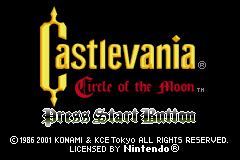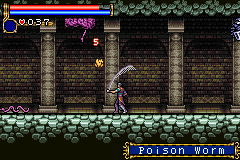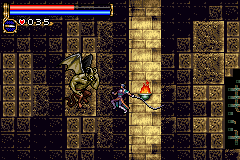Castlevania: Circle of the Moon Review
Graphics
Much like Symphony of the Night, Circle of the Moon gives players the chance to explore some nice looking areas in the castle. Each area is uniquely designed from each other, so players shouldn't’t feel like the areas are repeating each other. The color palette and environmental detail gives each area of the castle their own spirit. Unfortunately, there are a few areas that are reminiscent of those from Symphony of the Night. The Abyssal Stairway is reminiscent of Outer Wall; the Eternal Corridor is reminiscent of the hallway room of the Marble Gallery, and Triumph Hallway is reminiscent of Castle Entrance. But, the castle itself sin’t just what makes up the art of the series, it’s also the monsters. Unfortunately, though the monster were not as carefully designed and detailed as the environments they live in. Certain classes of enemies are merely palette swaps, which include but limited to: elemental demons, elemental armors, demonesses, were-beasts, and beast demons. Using palette swaps to create “new” monsters in any game is a decision that save developers time, but also detracts a player’s feeling that each new enemy that they encounter is unique from the last. But, it is not just the use of palette swaps that take away from that feeling, but also very design of the monsters themselves. The design of each monster in Circle of the Moon is designed after stereotypical designs of monsters from folklore, literature, and cinema (i.e. Witches look like the witch from the Wizard of Oz). This is unfortunate as the designs of many monsters in the series are designed uniquely from their sources.
Sound
The sound effects of many attacks by both Nathan and Dracula’s dark forces are fairly good, but with the lesser hardware capabilities of the Gameboy Advanced make those sounds a little worse than those from home consoles or PC. However, the music is almost as well done as it was in the previous entries. Much of the music sounding like it could be done or was done on an electronic keyboard. While these electronic sounds could never sound as good and clear as real instruments, it doesn’t mean that the ambient music of this game is not good. The sound track of each area gives each one of them a certain feeling or theme to them (the sound track for the beginning area sounds like Nathan is starting an intense journey). These soundtracks help create the game’s excellent atmosphere, which is something that the franchise has been doing since the beginning.
Gameplay
Items
Circle of the Moon offers the same gameplay style that was offered by Symphony of the Night; players explore the castle while killing monsters to level their character and collecting items. However, despite having the RPG elements that were popularized by Symphony of the Night, Circle of the Moon plays a little similar to the classic series. Nathan moves a fairly slow pace while his jump height isn’t very impressive, but this can resolved once players acquire the relics for sprinting and double jumping. Also similar to the classic series, candles drop either hearts or a sub-weapon not money. Because there is no money players cannot stock up on items by buying them from a vendor, instead they must kill enemies until they dropped the desired item. While this can make the game a little bit more challenging it also makes stocking up items an annoyance, as players will have to kill the same enemy repeatedly until they drop an item. However, this requires elongated time of killing enemies and exiting and reentering a room to respawn the enemies to repeat the whole process over again. Items, despite the tiring method of getting them, are staple feature of the game that is required to survive within Dracula’s Castle. There are two classes of items that can be dropped from enemies: usable items and equipment. Usable items are used to heal, recover hearts, recover magic, and cure any current ailments. Equipment, which is separated into Body, Cape, Hand, and Accessory, increases or decreases Nathan’s attributes depending the item equipped. Equipping armor and stocking up on items will help players survive.
Stats
As mentioned before, usable items are be used to recover health, hearts, magic, and from ailments. Health determines how long Nathan can stay alive, hearts determine the numbers of uses for sub-weapons, and magic determines how much he can use the card system. However, recovery from ailments is very important, as ignoring them will result in Nathan’s potential death. Poison will drain Nathan’s health over a short duration, Curse drains Nathan’s magic, and Petrify will prevent Nathan from moving. Also mentioned before was that equipment increase or decrease Nathan’s attributes, which are strength, defense, intelligence, and luck. Strength determines the amount of damage that can be dealt, defense determines the amount of damage that can received, intelligence determines the recovery speed of magic, and luck determines the drop rate of items. Increasing all of their attributes with careful equipment choose will help Nathan when facing off against Dracula’s minions.
Combat
Combat is fairly similar to how it was in the classic series, with classic sub-weapons such as dagger, holy water, axe, stopwatch, and cross returning. However, there are a couple things inherited from Symphony of the Night that are featured in this game: elements and magic. Circle of the Moon has extended the element system a little by adding a few more elements, and making each enemy have their own elemental resistances. The elements featured in Circle of the Moon are: Fire, Ice, Plant, Earth, Stone, Poison, Wind, Thunder, Holy, and Darkness. Each enemy will have resistances and weaknesses to these different elements, and figuring what element to use against what enemy is an important part of combat. However, Nathan can only use the elements through the dual-setup system or DSS. DSS is a card system that will vastly improve Nathan’s combat capabilities depending on the card combination, and the cards can only be received via item drop. These Cards are split into two categories: Attribute and Action. Attribute cards are cards that determine the special effect of a combination, and are represented by legendary creatures corresponding to the ten elements. Action cards are cards that determine base effect of a combination, and are represented by roman deities that give their own effect in combination with an attribute card. These combinations range from changing Nathan’s weapon, summons, defensive spells, offensive spells, and stat boosts. Now, while the different card combinations can be extremely useful, certain card combinations lose their luster after players find better cards. However, having certain card combination lose their luster isn’t the only issue with DSS, as DSS can also make the game far less challenging. Even, the most challenging bosses of the game can be beat easily with DSS. But, there is a special area of the castle that will remove the DSS completely. This area is the hardest challenge in the entire game, and it is the only to get the best items.
Story
Circle of the Moon’s story is standard Castlevania fair: Dracula is back, Kill him. This story is tiring, even for long time fans of the franchise. However, much like Symphony of the Night and Dracula’s Curse, the Circle of the Moon gives a larger cast of characters other than the vampire hunter and Dracula. However, unlike those games though, the supporting cast is poorly used, as they are only encountered in the beginning and towards the end. And like Maria in Symphony of the Night, there is one character that Nathan encounters, but unlike Maria these encounters are not very endearing. Another similarity to Symphony of the Night is that there is a boss that has dialogue, but they are utterly unimportant to the game’s storyline. The story ends the same way as pretty much every other castlevania; the cast on the good side watch on a nearby cliff as Dracula’s castle collapses.
Conclusion
Circle of the Moon is a good castlevania that will remind veteran series players of the classic games, due to Nathan’s slow pace. The dual setup system along with the equipment system and the vast exploration makes the game feel more vibrant. However, the dual setup system can significantly decrease the difficult of the game, especially in late game. Bosses are kind of challenging, but only the earlier bosses are fairly challenging since players will not have access to many DSS cards at that point. The bestiary is also a little flawed because many of the monsters are just palette swaps, and they can be easily devastated by late game DSS. Circle of the Moon is a good game, whose main feature takes away from the challenge of the game.


 User Notice
User Notice 








